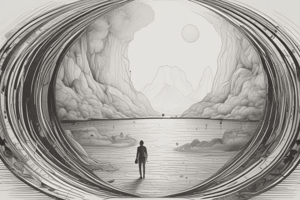Podcast
Questions and Answers
What is the main function of cones in vision?
What is the main function of cones in vision?
- Detect motion
- Enhance night vision
- Process depth perception
- Detect color (correct)
Which theory explains the phenomenon of negative afterimages?
Which theory explains the phenomenon of negative afterimages?
- Trichromatic theory
- Opponent-process theory (correct)
- Gestalt principles
- Feature detector theory
What do feature-detector cells in the visual cortex respond to?
What do feature-detector cells in the visual cortex respond to?
- Specific shapes and orientations (correct)
- Background patterns
- Brightness levels
- The overall color spectrum
What is a characteristic of the trichromatic theory of color vision?
What is a characteristic of the trichromatic theory of color vision?
How does the opponent-process theory explain the perception of colors?
How does the opponent-process theory explain the perception of colors?
Which Gestalt principle explains why we perceive columns rather than rows in a diagram with dots?
Which Gestalt principle explains why we perceive columns rather than rows in a diagram with dots?
What does the principle of closure indicate in visual perception?
What does the principle of closure indicate in visual perception?
What phenomenon explains why an object appears the same size despite being closer or farther away from the observer?
What phenomenon explains why an object appears the same size despite being closer or farther away from the observer?
Which term describes the perception of colors being influenced by surrounding colors?
Which term describes the perception of colors being influenced by surrounding colors?
Which of the following is an example of depth perception using binocular cues?
Which of the following is an example of depth perception using binocular cues?
What is the term for the phenomenon where a person walking towards you does not appear to increase in size?
What is the term for the phenomenon where a person walking towards you does not appear to increase in size?
What explains why two lines that are equal might appear different in length due to contextual elements?
What explains why two lines that are equal might appear different in length due to contextual elements?
Which of the following refers to the brain's ability to maintain a perception of an object's brightness despite changes in lighting?
Which of the following refers to the brain's ability to maintain a perception of an object's brightness despite changes in lighting?
Which concept describes the stable perception of an object regardless of changes in viewing conditions?
Which concept describes the stable perception of an object regardless of changes in viewing conditions?
What visual cue is characterized by the slight difference in the view from both eyes?
What visual cue is characterized by the slight difference in the view from both eyes?
What psychological principle would you apply to explain why we perceive an object as larger when viewed against a smaller background?
What psychological principle would you apply to explain why we perceive an object as larger when viewed against a smaller background?
Which Gestalt principle is illustrated when the brain interprets overlapping objects as separate entities?
Which Gestalt principle is illustrated when the brain interprets overlapping objects as separate entities?
Which Gestalt principle is applied when we perceive similar colored shapes as a single group?
Which Gestalt principle is applied when we perceive similar colored shapes as a single group?
Which of the following best describes perceptual constancy?
Which of the following best describes perceptual constancy?
Which cognitive phenomenon refers to our tendency to perceive a constant color for an object despite changes in illumination?
Which cognitive phenomenon refers to our tendency to perceive a constant color for an object despite changes in illumination?
What is the primary reason for visual illusions being valuable to the understanding of perception?
What is the primary reason for visual illusions being valuable to the understanding of perception?
Flashcards are hidden until you start studying
Study Notes
Constructing the Visual World
- Form perception utilizes Gestalt principles to organize sensory information into meaningful patterns.
- Proximity: Objects that are close together tend to be grouped.
- Closure: The mind automatically fills in gaps to create complete shapes.
- Similarity: Items that share similar attributes are perceived as related.
- Continuity: Lines and patterns are perceived as continuous, even if they shift direction.
Depth and Distance Perception
- Binocular cues: Depth perception relies on information from both eyes.
- Convergence: Eyes turn inward when focusing on nearby objects.
- Retinal disparity: Slight differences in the images seen by each eye provide depth information.
- Monocular cues: Depth perception can also be achieved using one eye.
Visual Constancies
- Perceptual constancy enables recognition of stable objects despite variations in sensory input:
- Size constancy: Objects maintain perceived size regardless of distance.
- Shape constancy: Shapes are perceived as the same despite changes in orientation.
- Location constancy: Objects are perceived as stable despite movement.
- Brightness constancy: Brightness remains constant under varying lighting conditions.
- Color constancy: Colors are perceived consistently despite changes in light.
Visual Illusions
- Perceptual illusions reveal systematic errors in perception, hinting at cognitive strategies.
- Müller-Lyer illusion: Identical lines appear different due to contextual cues.
- Perception can be influenced by surrounding colors; the same color may be perceived differently based on context.
- Illusions demonstrate that perception is not always an accurate reflection of reality.
Visual System and Color Perception
- Trichromatic theory: The eye contains three types of cones sensitive to red, blue, and green light; combinations create other colors and explain color-blindness.
- Opponent-process theory: This theory posits color perception occurs in opposing pairs (red-green, blue-yellow, black-white); it accounts for negative afterimages.
Feature Detection
- Feature-detector cells in the visual cortex respond selectively to specific shapes and patterns, enabling complex visual processing.
Studying That Suits You
Use AI to generate personalized quizzes and flashcards to suit your learning preferences.




